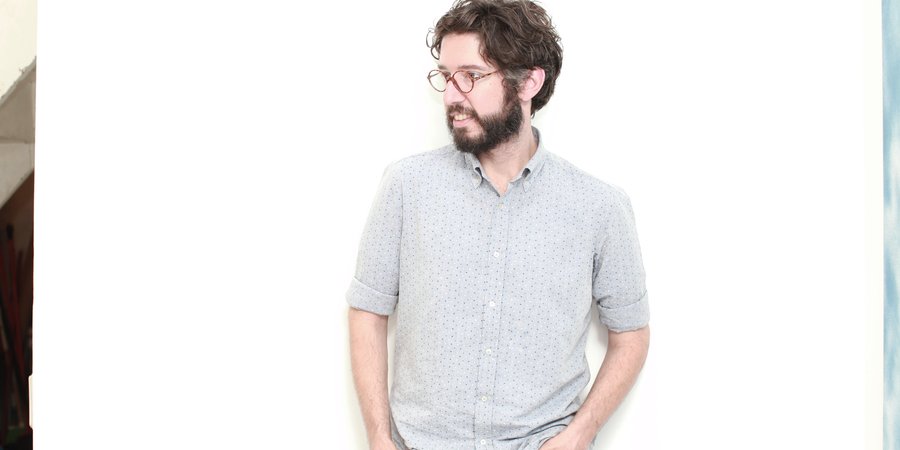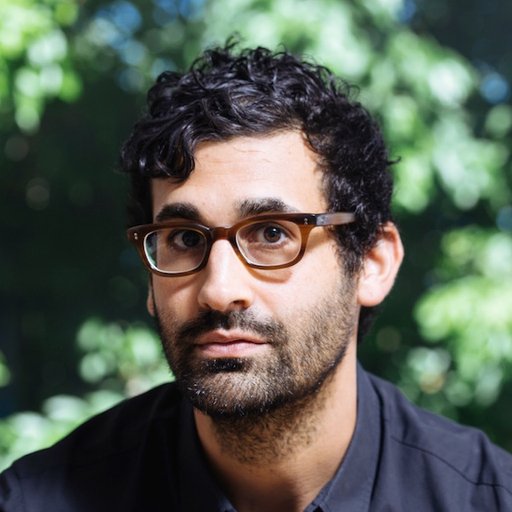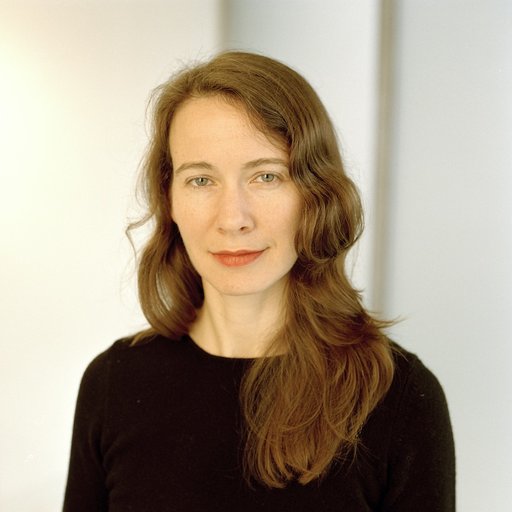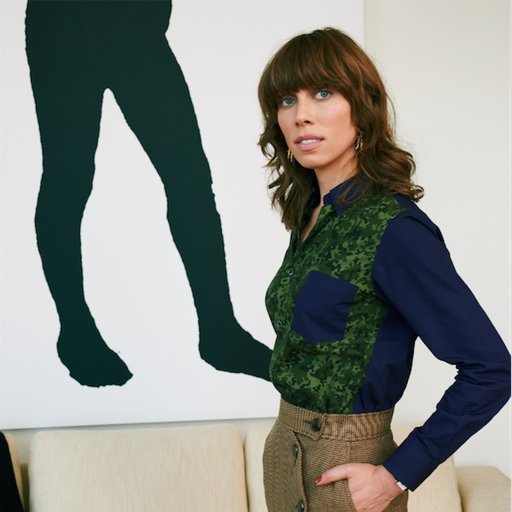If Brett W. Schultz has his way, Mexico City may soon be topping the list of art-world capitals. Together with his partner Daniela Elbahara, the Chicago transplant has spent most of the past decade nurturing the nascent art scene in his adopted city—first through the project space-cum-galley Yautepec and now with the Material Art Fair that the pair founded just last year.
Dedicated to emerging galleries and especially small artist- or curator-run spaces, Material’s exuberant first edition received rave reviews and lured collectors from the more established fair Zona Maco. This year’s lineup boasts more exhibitors, an expanded public program, and a new location in the beautiful neighborhood of Condesa. We caught up with Brett as he put the final touches on this year’s fair to talk about the origins of Material, his hopes for Mexico City’s galleries, and the secret to running a successful project space.
Let’s start at the beginning: How did you go about creating a fair more or less from scratch?
The idea arose from our experience running Yautepec. We had done Zona Maco three years in a row, and we felt like we were not in the right place there. In the main fair you’re competing with huge blue-chip galleries showing name brand artists, and we always felt like we were stuffed away in a corner. We didn’t feel like we were getting a return on investment. Even more than that, it just never felt personal. We were talking endlessly with our gallerist friends from elsewhere, all of whom were really excited about the idea of a smaller, younger fair in Mexico City. Everyone loves Mexico City and wants to be here, but Maco was never the right profile for them. Really, we wanted to make a boutique experience that focuses on the exhibitors.
The exhibitors that you’re bringing in are almost entirely small, youthful operations with experimental or somewhat informal programs. What was it like organizing 40 of these kinds of spaces across three continents in preparation for the fair?
Honestly, everyone is pretty professional. We try to make it easy for them. Even price-wise, we try to help the galleries because we know that international art transportation can be expensive. Once you’re here in Mexico City it’s not expensive at all, and we just want to make sure that the booth prices are low enough that if a good sale comes in to one of these smaller galleries, they can afford a booth at Material.
This is only the second year of Material. What’s changed this time around?
It’s way more international this year. Eighty-seven point five to 90 percent of the exhibitors are international this year, and 70 percent are first time exhibitors for the fair. That tells you a lot about the kind of success we’ve had, word-of-mouth-wise, with the exhibitors from last year.
The big difference this time around is going to be the venue. Last year we were in a hotel convention center, and it felt like that. The space itself didn’t have much personality. Now we’re in the Auditorio Blackberry in Condesa, which is one of the nicest neighborhoods in Mexico City in terms of green space, restaurants, bars, and all that, while also being centrally located and convenient. We’re taking over the entire venue this year, so once you enter you’re in Material. You’re not looking for Material inside a hotel. We’re expecting a much larger public, because we’ve been getting a ton of press. We got an earlier start on everything this year, so I think we’ll make a much bigger splash.
Some art world types love to hate on the international art fair circuit. How does Material fit into or defy these stereotypes?
Well, fairs are fairs. It’s not like we’re trying to create something anti-market here. We want to create space for galleries and artist-run spaces here to gain visibility and make sales to be able to sustain their programs, and for international galleries to come and meet collectors that they wouldn’t meet elsewhere. It’s an art fair, but because it’s relatively inexpensive it’s easier for galleries to do something risky without having to be overly concerned about making tens of thousands of dollars just to break even.
We also have a great public program this year. We’ve got a video program curated by Anna Gritz from South London Gallery, and we’re working with Triple Canopy for our series of conversations for the conference program. And Mexico City itself has a lot to offer. In our own way, we’re making the city a less scary place to visit. A lot of people still have these terrible stereotypes about Mexico City, which are really more about what’s happening elsewhere in the country, and they expect to come here and see people riding burros. It’s just ridiculous. One of the things we’re trying to do is place Mexico City solidly within the international contemporary art scene.
How would you characterize the kind of collectors you’re working with in Mexico City?
One very interesting thing about the first edition was that the clear majority of sales went to foreign collectors. Maco has always been a fair that attracts a lot of foreign collectors. We decided to run Material parallel to Maco in part because Maco receives a lot of public funding to fly in curators and collectors from elsewhere. It really becomes the most important week for contemporary art in Mexico City, so we wanted to build on that and expand what’s on offer. This year, we’ve made a lot more effort to reach out to the important Mexican collectors to make sure they know what’s coming. We really want more of the work that’s shown here to stay here, to go to both private and institutional Mexican collections. That’s something we’re expecting to happen for this edition.
Is that part of the reason behind the international focus? Less than half the exhibitors are from Latin America, and only a handful are from Mexico itself.
Honestly, we’d love to have more galleries from Central and South America, but our network is stronger in the States and in Europe for the moment. We’re working hard to strengthen our network in Latin America, and this year is just a step in that direction. We have applications from a lot of the artist-run spaces here in Mexico, but the commercial gallery scene is really locked into Maco. They’re not going to leave Maco to come to our fair, nor would we necessarily want that. Our strength in Mexico lies in giving visibility to the artist-run spaces.
In terms of the selection process, we’re really trying to put everyone on an equal level. It’s not like we have a quota for the number of Mexican galleries or project spaces that need to be in the fair in order for it to be a Mexican fair. We do what we can to include as many of the Mexican spaces as possible, but within the fair it’s competitive. It’s all about quality, so everyone has to step up their game.
Could you tell us a little more about the selection process? What are the criteria for getting a booth at Material?
There’s a core philosophy to the whole process, which is basically that we change the selection committee entirely every year. We want the fair to remain fresh, and we don’t want it to get really Mafioso. We want to give galleries that maybe didn’t get in this year a fighting chance to get in next year. There is an initial filter, though, which is the list we maintain of the galleries and spaces that we find interesting internationally and that we think might be good material for Material. It’s an invitation-only application process. The selection committee goes through these applications and gives each one a rating, and then it goes into a second round where we decide how to allot these 40 spaces.
There’s a real New York presence in this fair. As you mentioned, Triple Canopy is organizing the public program, Beverly’s is running the exhibitors club, and there are almost twice as many galleries from New York as there are from Mexico City. What are we to make of this New York connection?
It’s an important bridge to make, because New York is the media center for contemporary art worldwide. We’re interested in a lot of what’s going on there, but we also want them to take an interest in Mexico City. Triple Canopy has already been involved. They’ve been working on a seminar and workshop program with a group of artists and thinkers from Mexico City for the last three or four months, so this program was an opportunity to build on what they’ve already done.
Dan Sutti is one of the owners of Beverly’s and also one of my best friends from high school, so he’s known about Material since it was just an idea in our heads. This was a nice way for us to get to work together. There are always these exclusive spaces for VIPs, but no one ever really makes a space in the fair just for the exhibitors. We wanted to create this kind of exhibitors’ club, knowing that Beverly’s really caters to the gallerist and artist scene in the Lower East Side.
As far as the galleries go, Clifton Benevento, Regina Rex, and Queer Thoughts were all in the fair last year, but there’s also a lot of newcomers. American Medium, Grand Century, P!—none of these were in the fair last year. We have a good network in New York, and I think it’s important to make those connections. At the same time, we’d like strengthen our connections to Los Angeles, London, Paris, Berlin, but also Bogotá, Buenos Aires, and Lima. I think it’s very important to make these bridges.
There’s a huge amount of buzz around Mexico City in the art world these days, in part because of projects like Material. What do you think of the current state of the city’s art scene, and where do you think it’s going?
You know, it’s still small, and I think change happens pretty slowly here. The biggest change of the last two years has been the rise of the artist- and curator-run project scene. For years it was this small group of commercial galleries, and that was just what you expected to see at Maco every year. The presence of Material coincided nicely with the rise of this project space scene to breathe new life into the city.
What you have here is a city that is geographically close to other art world centers but has a very different feel to it. It’s cheap to live here for artists, and it’s also a smaller world. If you come down here and get yourself into the contemporary art scene, it’s easy to get noticed. It’s not like New York or L.A. where you’re competing with ten thousand other artists who are all doing the same thing that you’re doing.
How do you think this relative lack of competition coupled with the low cost of living in Mexico City affects the kind of art being made there?
In a sense I think it takes a lot of the pressure off. If you're trying to survive as an artist in New York you have to cater to certain market demands, and if you hit on some sort of successful formula you almost have to continue making those works ad infinitum just because you have excessive bills and rent to pay. I think that here in Mexico City it’s a bit more relaxed. It gives you a little more room for experimentation, and everything somehow feels less competitive.
What’s the state of the contemporary art market in Mexico City?
There are only a handful of serious collectors who are interested in the kind of work that’s shown at Material, but they are serious about it. That’s also one of the reasons why it's great that we have such a strong influx of foreign collectors around fair time to bolster our sales while the market picks up here. It’s a huge part of the mission of Material to promote new work and new modes of production while at the same time creating the marketplace for it here in Mexico City. The market is growing and growing quickly.
As the fair’s organizer I’m sure you’re a bit leery of playing favorites, but if you had to say, whose booth are you most excited to see this year?
I think I’m going to promote some of the underdogs, because the project space section we have this year is just so cool. We created seven spaces that are free to the participating projects if they are selected. The spaces are small, and we can’t pay for them to come down, but if they can make their own way they have that space for free.
We’ve got some very exciting proposals from Grand Century and Parallel Oaxaca. Parallel’s booth will be curated by Attilia Fattori Franchini, the Associate Director at Seventeen Gallery in London who has spent quite a bit of time in Mexico City recently. We’re also really excited about the proposal from a space called Casa Imelda here in Mexico City. Hardly anyone even from the City has heard of Casa Imelda, but it’s this very small residency and studio space whose current visiting artist is Sergio Verastegui, the incredible Peruvian artist currently living in Paris. He’s been winning prizes left and right in France, and has wanted to show his work in Mexico for a long time. As far as other Mexican spaces go, Lodos and Lulu are two of the strongest programs to emerge from this project space scene that’s happening in Mexico. These two galleries moved up from the project space booths they had last year to more “real” stands at the fair this year.
Queer Thoughts has a great proposal to show this very mysterious French artist named David Rappeneau alongside a performance of the artist Puppies Puppies from Chicago. It’s going to be a very bizarre, Spongebob-oriented performance. Spongebob is going to be protesting at the fair, basically. Helper Gallery from Brooklyn also has a really bizarre proposal, New Galerie is bringing a really tight presentation with Sean Raspet, Nico Colon and Dora Budor, Night Gallery is going to have a great exhibiton of Mira Dancy and Augustus Thompson, and Clifton Benevento is doing a solo presentation of Gina Beavers’s amazing new work. I can go on and on, because really I’m excited about all the proposals. I think we’re going to see some pretty cool stuff.
As someone who came up through the project space scene in Mexico City and is now in the position of evaluating similar efforts, what would you say is the secret to success?
It has to be more than a vanity project. The spaces that I see as the most successful are the ones that have an individual or small group of people who take it upon themselves to give attention to a certain scene or group of artists. These scenes may extend internationally, of course, because that’s happening more and more these days as artists connect via social media and create these linked practices of people who may not know each other in person. The best project spaces are the ones that tap into a group of artists who are working towards something similar via different means.
With regard to the growing importance of art fairs, I think the postponement of FIAC Los Angeles is especially interesting because it suggests that the market is hitting its saturation point for big international fairs. I don’t think the year’s schedule can handle many more, and I don't think there are enough big galleries anymore to keep so many of those fairs afloat.
I think it’s time for a new model for fairs that’s smaller and that actually helps out the artist-run spaces by giving them the ability to exhibit on a larger stage. The market is changing. It’s harder and harder for the small to midsize commercial galleries to survive because these vital art fairs are so expensive, because the successful galleries are able to pay a ton of money to be there which in turn inflates all of the prices in general. The rise in the number of artist-run spaces internationally is indicative of a kind of carving out of the market to create the possibility to exist for these small to midsize commercial galleries. That was a big part of how we formulated Material—we asked, “Can we make a fair that helps out small to midsize galleries like our own that also reflects the changes in the contemporary exhibition ecosystem?”
When the dust settles after the fair, what’s next for you?
Getting started on 2016! We get maybe a couple weeks off before we need to start working on the next edition. It’s really year-round work, and we take it seriously. We sometimes toy with the idea of what Material would look like if we were to do a spin-off in another city, but that’s just an abstract idea at the moment. While there’s not room in the global marketplace as I see it for more large fairs, I think there is room for more fairs like Material. Hopefully our fair will help to create a more stable marketplace for the smaller galleries out there. We think this is important work, because we can’t just have a world of Gagosians.























